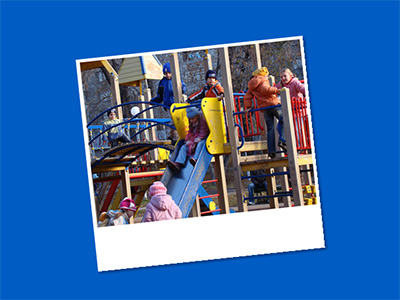 |
Course 36: Sharing Information with Parents and Other Professionals |
2.00 |
School-age children work on many important developmental tasks during their out-of-school hours. One of the important responsibilities of OST staff is to help parents stay in touch with how their children are growing and developing during program hours. In addition to parents, professionals who work with children in other settings are often interested in learning how children spend their time when they are not at home or school.
Portfolios are excellent tools for bringing children’s experiences in OST programs to life for parents during planned parent conferences. They are also valuable tools for sharing helpful information about children with other professionals. |
 |
Providing Homework Support (Collection) |
2.00 |
The National Standard Objectives of Learning (SOL) have raised questions about the role of school-age programs in providing homework help and support. Research indicates there are many different ways to provide effective homework support in school-age programs. Some are more structured than others. When planning a homework support program, it is important for school-age programs to develop a homework philosophy that is consistent with the program’s overall philosophy and reflects current research on best practices for providing homework help. The homework philosophy should also reflect the needs of parents and children in the program and strike a balance between homework needs and other experiences that help children grow and learn out-of-school. When staff know how to design homework environments, identify appropriate homework materials, and use effective strategies to guide children’s efforts, homework support can be an effective component of ongoing programs. |
 |
Course 26: Human Relations Skill Development: Focus on Leadership Styles and Conflict Management |
2.00 |
Research indicates that those in positions of leadership use a variety of different leadership and management styles. A person’s effectiveness as a leader is often directly linked to his or her leadership style. It is important for OST professionals to be aware of the assumptions and characteristics of different leadership styles. Knowledge of different leadership styles can help OST professionals reflect on their own leadership style and assess its effectiveness. It can also help OST professionals take a proactive approach to applying different leadership styles and techniques, depending on the situation.
Leaders also use a variety of different styles when it comes to managing and resolving conflicts. By understanding how to diagnose the causes and dynamics of conflict and understanding the characteristics of different conflict management styles, OST professionals can choose the best conflict management strategy for each situation.
There are a number of skills that enhance the ability of OST professionals to employ different leadership and conflict management styles effectively. When OST professionals are aware of these skills and their own skill levels, they can set priorities for ongoing development of leadership skills. |
 |
Human Relations Skill Development (Collection) |
2.00 |
Being able to communicate effectively is an essential human relations skill for school-age care professionals. To be a good communicator, school-age professionals need to understand the components of communication and how the communication process works. They need to identify barriers to clear communication and develop strategies for minimizing or eliminating barriers to communication. School-age care professionals also need to work cooperatively with other team members to solve problems and conflicts. This requires an understanding of how teams work and the characteristics of effective teams. Assessing the current status of personal human relations skills helps each professional identify priorities for making improvements to these skills. |
 |
Course 09: School-Age Care as a Family Service - Part One |
2.00 |
Strong, positive, cooperative relationships with parents and families are at the heart of quality school-age programs. Unfortunately, positive relationships with parents and families are not always easy to achieve because parents, like children, have widely varying personalities; some are easier to reach than others. Parents in school-age programs have different ideas, values, concerns, knowledge, pressures, lifestyles, plans, dreams, resources, and constraints. Staff who are successful in building positive relationships begin by recognizing the importance of accepting parents as the most important people in children’s lives, regardless of differences among them. They understand that staff attitudes toward parents can have a strong effect on whether or not staff can establish positive relationships with parents. Staff in quality programs make a commitment to learning as much as possible about parents’ needs, interests, wants, and concerns and develop effective strategies for making positive connections with parents. |
 |
Course 33: Youth Development Trends: Focus on Older Youth |
2.00 |
The Center for Early Adolescence at the University of North Carolina and the Search Institute have found that early adolescence is a time of rapid change in youth development and developmental needs. For many children, the characteristic needs of early adolescence begin to emerge as early as age nine, when children are still in elementary school and attending traditional OST programs. OST professionals who understand these emerging needs are better equipped to create successful program experiences with older children in their programs.
The number of quality OST programs for children between five and twelve is steadily growing across the country. At the same time, there is increasing public interest in establishing programs that can also address and support the out-of-school needs of children over age twelve. For many years, communities tried to meet the needs of older youth by a problem-solving approach that focused on helping youth by fixing what was wrong. New trends in youth development take a more positive approach and are focused on working with youth to create positive outcomes.
OST professionals who are knowledgeable about adolescent development and developmental needs and are knowledgeable about youth development research and trends can play important roles in helping their communities design and develop the next level of program services for children over the age of twelve. By learning about ways to support the developmental needs of older youth, OST professionals can join with others to create strategies and programs for continuing to build on the positive experiences younger children have in their OST programs. |
 |
Guiding School-Age Children in Groups (Collection) |
2.00 |
When large numbers of children are involved in the program, it is challenging to create and deliver school-age program activities that can meet the needs of all children. The key to success is taking a systematic approach to program planning. It is important for staff to understand how to select appropriate activity options and use effective management strategies that make it possible to offer a balanced variety of simultaneous activity options. This understanding will help staff plan and implement a program that effectively supports, nurtures, and guides individual differences and fosters positive interaction among children in groups. |
 |
Elephants |
2.00 |
This course will provide an introduction to elephants, including an overview of physical characteristics, habitat, behavior, reproduction and the conservation efforts dedicated to protecting this species. |
 |
Growing as a Professional in School-Age Programs (Collection) |
2.00 |
Caring for school-age children in a school-age program is a relatively new field of work. The field itself is constantly changing and expanding. In view of this "newness" and change, those who work in the field are playing an important role in shaping and defining what it means to be a school-age professional. They are guiding school-age care as an emerging profession.
In the search for a definition of professionalism in school-age programs, it is helpful to examine the common characteristics of professionalism in other fields. The next step is identifying qualities and characteristics associated with professional behavior in the school-age field, itself. As a school-age professional, it is also important to understand the importance of acting as a public policy advocate on behalf of school-age children and their families.
An important part of professionalism is continued personal growth and development in relation to the field. This requires using appropriate resources and strategies to further individual professional development. It also requires considering what constitutes ethical conduct in the field and developing an ongoing commitment to ethical behavior. |
 |
Course 18: Exploring Effective Schedules, Diverse Activity Formats, Planning Tools, and Staff Roles |
2.00 |
Flexible schedules make it possible to provide a varied program of activities that support the developmental needs and interests of school-age children. By establishing a flexible schedule, school-age staff can plan and implement a variety of different activity formats. To develop a balanced program, it is important for school-age staff to take a systematic approach to both short-term and long-range planning. Staff can use a variety of different planning tools to plan different types of activities. To implement a diverse program of activities, it is essential for school-age staff to recognize and use a wide variety of different roles as they interact with children throughout the program day.
|
 |
Course 10: School-Age Care as a Family Service – Part Two |
2.00 |
The foundation for getting parents involved in school-age programs is to keep parents well informed about what is happening in the program. Quality programs also provide parents with opportunities to make suggestions and give feedback on program services through suggestion boxes, feedback forms, and surveys. When parents are encouraged to have input in the program, they develop trust and confidence in the program and feel a sense of pride and ownership. They are much more likely to participate as resourceful partners with program staff when they know their ideas are welcome and valued. Finally, because parents are all different from each other, it’s important to provide many different opportunities for them to connect with the program. Staff in quality school-age programs recognize that all parents don’t have to be involved in the same way. |
 |
Course 31: The Six "Ps" of Marketing School-Age Programs |
2.00 |
Effective marketing of OST programs is a systematic process that involves research, analysis, assessment of market trends and needs, short-term and long-term planning, and development of effective strategies to promote OST program services and develop a positive image of the program in the community. It is important for OST leaders to recognize that marketing is a far reaching process that includes, but is not limited to, advertising and publicity. When OST leaders take a comprehensive approach to marketing, their programs and projects have an excellent chance of success. Knowledge and understanding of the marketing process is an invaluable tool for OST leaders as they plan and implement new programs and projects, assess the stability and need for improvement of current programs, develop plans for new or expanded programs, and develop a positive public image of the program and its services. |
 |
Course 12: Growing as a Professional in School-Age Programs |
2.00 |
Caring for school-age children in a school-age program is a relatively new field of work. The field itself is constantly changing and expanding. In view of this "newness" and change, those who work in the field are playing an important role in shaping and defining what it means to be a school-age professional. They are guiding school-age care as an emerging profession.
In the search for a definition of professionalism in school-age programs, it is helpful to examine the common characteristics of professionalism in other fields. The next step is identifying qualities and characteristics associated with professional behavior in the school-age field, itself. As a school-age professional, it is also important to understand the importance of acting as a public policy advocate on behalf of school-age children and their families.
An important part of professionalism is continued personal growth and development in relation to the field. This requires using appropriate resources and strategies to further individual professional development. It also requires considering what constitutes ethical conduct in the field and developing an ongoing commitment to ethical behavior. |
 |
Youth Development Trends: Focus on Older Youth (Collection) |
2.00 |
The Center for Early Adolescence at the University of North Carolina and the Search Institute have found that early adolescence is a time of rapid change in youth development and developmental needs. For many children, the characteristic needs of early adolescence begin to emerge as early as age nine, when children are still in elementary school and attending traditional OST programs. OST professionals who understand these emerging needs are better equipped to create successful program experiences with older children in their programs.
The number of quality OST programs for children between five and twelve is steadily growing across the country. At the same time, there is increasing public interest in establishing programs that can also address and support the out-of-school needs of children over age twelve. For many years, communities tried to meet the needs of older youth by a problem-solving approach that focused on helping youth by fixing what was wrong. New trends in youth development take a more positive approach and are focused on working with youth to create positive outcomes.
OST professionals who are knowledgeable about adolescent development and developmental needs and are knowledgeable about youth development research and trends can play important roles in helping their communities design and develop the next level of program services for children over the age of twelve. By learning about ways to support the developmental needs of older youth, OST professionals can join with others to create strategies and programs for continuing to build on the positive experiences younger children have in their OST programs. |
 |
Course 17: Developing and Implementing Effective School-Age Outdoor Environments and Interest Areas |
2.00 |
School-age children need daily opportunities to exercise, relax, and participate in a wide range of outdoor activities. The hours children spend in after school programs are often the best hours of the day for getting fresh air and enjoying the out of doors while it is still daylight. School-age programs can provide safe, secure settings where children can enjoy the out of doors. Even if outdoor space is limited, regular participation in a wide variety of physical activities in the open air can help children develop healthy exercise habits that will last a lifetime. |
 |
Course 29: Making Plans and Developing Policies |
2.00 |
Planning and policy-making are closely linked to the development of quality OST programs. When OST staff are skilled as planners and policy-makers, they can use these skills to design and implement high quality programs that benefit children, youth, and families. It is essential for OST professionals to recognize that it is important for policies to grow out of a vision of quality and a mission that supports that vision. Therefore, creating a vision for quality, developing a program philosophy, and writing a clear mission statement are the first steps in program planning. It is also important for OST professionals to use a systematic process to develop goals and objectives, set priorities for accomplishing goals and objectives, and develop goal-based action plans that will help the OST program achieve its mission. High quality OST programs are led by professionals who understand how to use effective strategies for creating a continuous cycle of planning and evaluation that supports ongoing program improvement. |
 |
Course 11: Building Relationships with School Personnel |
2.00 |
School-age programs and schools share a mutual goal of supporting the growth, development, and learning of school-age children. Over 50% of all school-age programs nation-wide are housed in school facilities. When school-age programs are housed in school facilities, it is essential for staff in school-age programs to establish and maintain a positive relationship with school personnel. This makes it possible for schools and programs to work together to support the needs of the whole child. Staff can develop successful partnerships with school personnel by cultivating an understanding of the needs, interests, and goals of school personnel and using effective strategies, tools, and systems to build a spirit of positive collaboration and communication. |
 |
Developing Effective Outdoor Environments and Interest Areas (Collection) |
2.00 |
School-age children need daily opportunities to exercise, relax, and participate in a wide range of outdoor activities. The hours children spend in after school programs are often the best hours of the day for getting fresh air and enjoying the out of doors while it is still daylight. School-age programs can provide safe, secure settings where children can enjoy the out of doors. Even if outdoor space is limited, regular participation in a wide variety of physical activities in the open air can help children develop healthy exercise habits that will last a lifetime. |
 |
Course 04: Exploring Individual Differences in School-Age Children |
2.00 |
One of the most significant challenges for staff in OST programs is learning how to identify, manage, and respond appropriately to individual differences in a group setting. Some differences among children are the result of inborn characteristics and traits (e.g. physical characteristics, temperament, talents, race). Other differences are the result of external factors (e.g. the environment) or are cultivated as the child grows and develops (e.g. interests, skills, knowledge). The diverse needs, characteristics, interests, abilities, and skills of school-age children require a flexible atmosphere that supports diversity and choice for children with varying capacities for independent action. Staff who understand and appreciate individual differences in children are better equipped to plan and implement program experiences that help individual children grow and flourish in a group setting. |
 |
Birds |
2.00 |
This course will provide an introduction to birds, including an overview of physical characteristics, habitat, behavior, reproduction and the conservation efforts dedicated to protecting this taxonomic group. |
 |
Course 28: Commitment to Quality in School-Age Programs |
2.00 |
School-age child care programs were prevalent during World War II. Many mothers worked outside the home to support the war effort and needed care for their children. When the war ended, school-age child care programs disappeared almost overnight as mother chose to stay at home. School-age programs emerged again in the late 1960’s in response to the vast numbers of mothers across the nation who were re-entering the workforce. National surveys in the 1970’s indicated that at least two-thirds of mothers with school-age children were again employed outside the home. The divorce rate was increasing as well as the number of households headed by a single parent. As a result, many elementary school children spent hours alone from 3:00 to 6:00 when school was out. Clearly, there was a growing need for out-of-school support services for school-age children.
In the 1970’s programs were commonly known as school-age child care or extended day programs. Those establishing programs gave their attention to increasing the availability and affordability of after school services for working parents. By the mid 1970’s, child care advocates also emphasized the importance of providing quality programs. Child care advocates, parents, educators, public policy experts, and representatives from a wide variety of child care and community organizations began a national dialogue to explore and identify the components of quality school-age child care services. Today, national, state, and local organizations are working to educate the public about quality school-age child care services and assist school-age child care professionals achieve quality programming in their communities.
It is essential for OST professionals to be aware of the national and state organizations, research, and practices that focus on the development of quality school-age child care programs. This makes it possible for OST professionals around the country to learn about the dimensions of quality OST/SACC programs and participate in the important process of continuous improvement of their own programs. |
 |
Course 19: Involving School-Age Children in Activity Planning and Implementation |
2.00 |
As they grow and change and move toward independence, school-age children and youth become very interested in planning and directing their own activities. This means it’s very important for staff to think of ways to involve them in program planning and implementation. By planning activities WITH children instead of FOR them and engaging them in creating the program environment, staff can help children develop a feeling of ownership of the program – a positive feeling that the program belongs to them. |
 |
Course 08: Human Relations Skill Development |
2.00 |
Being able to communicate effectively is an essential human relations skill for school-age care professionals. To be a good communicator, school-age professionals need to understand the components of communication and how the communication process works. They need to identify barriers to clear communication and develop strategies for minimizing or eliminating barriers to communication. School-age care professionals also need to work cooperatively with other team members to solve problems and conflicts. This requires an understanding of how teams work and the characteristics of effective teams. Assessing the current status of personal human relations skills helps each professional identify priorities for making improvements to these skills. |
 |
Sharing Information with Parents and Other Professionals (Collection) |
2.00 |
School-age children work on many important developmental tasks during their out-of-school hours. One of the important responsibilities of OST staff is to help parents stay in touch with how their children are growing and developing during program hours. In addition to parents, professionals who work with children in other settings are often interested in learning how children spend their time when they are not at home or school.
Portfolios are excellent tools for bringing children’s experiences in OST programs to life for parents during planned parent conferences. They are also valuable tools for sharing helpful information about children with other professionals. |
 |
Emergency Animal Recall - Polar Bears |
2.00 |
Welcome to Emergency Animal Recall. This Overview course covers the fundamentals of Emergency Recall training for exhibit animals, including:
What exactly is Emergency Animal Recall, and why is it necessary?
What are the benefits of Emergency Animal Recall?
How do you generate support within your organization for a training program, and how do you decide which animals should be trained first?
What equipment will you need, and what preparations will you need to make?
What is the general outline of an Emergency Recall training program, and how do you maintain the conditioning once it has been established?
This is the first course in a series. After completing this Overview, you should continue with the species-specific Polar Bear Emergency Animal Recall course. |


























